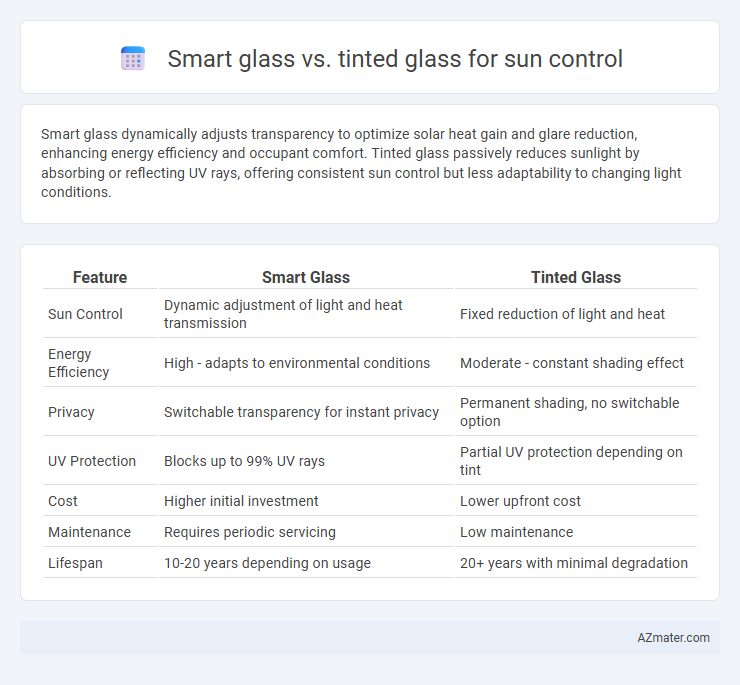Smart glass dynamically adjusts transparency to optimize solar heat gain and glare reduction, enhancing energy efficiency and occupant comfort. Tinted glass passively reduces sunlight by absorbing or reflecting UV rays, offering consistent sun control but less adaptability to changing light conditions.
Table of Comparison
| Feature | Smart Glass | Tinted Glass |
|---|---|---|
| Sun Control | Dynamic adjustment of light and heat transmission | Fixed reduction of light and heat |
| Energy Efficiency | High - adapts to environmental conditions | Moderate - constant shading effect |
| Privacy | Switchable transparency for instant privacy | Permanent shading, no switchable option |
| UV Protection | Blocks up to 99% UV rays | Partial UV protection depending on tint |
| Cost | Higher initial investment | Lower upfront cost |
| Maintenance | Requires periodic servicing | Low maintenance |
| Lifespan | 10-20 years depending on usage | 20+ years with minimal degradation |
Introduction to Sun Control Glass Solutions
Sun control glass solutions include smart glass and tinted glass, both designed to reduce solar heat gain and enhance energy efficiency in buildings. Smart glass adapts dynamically to changing sunlight conditions through electrochromic technology, allowing precise control over transparency and heat transmission. Tinted glass relies on a permanent color or coating to block or absorb solar radiation, offering a cost-effective means to minimize glare and UV exposure.
What is Smart Glass?
Smart glass, also known as switchable glass, is a type of glass that can change its light transmission properties automatically or manually to control heat and glare from the sun. Unlike traditional tinted glass, which has a fixed color or shade, smart glass uses technologies such as electrochromic, photochromic, or thermochromic coatings to adjust transparency and block solar radiation dynamically. This capability enhances energy efficiency by reducing the need for air conditioning and artificial lighting, making smart glass an advanced solution for sun control in buildings and vehicles.
What is Tinted Glass?
Tinted glass is a type of glass that contains additives or coatings designed to absorb and reduce solar heat and glare while allowing visible light to pass through. It works by altering the glass's color or optical properties to control the amount of sunlight entering a building or vehicle. This cost-effective solution helps improve energy efficiency by minimizing cooling loads and enhancing occupant comfort.
Key Differences Between Smart Glass and Tinted Glass
Smart glass offers dynamic sun control by adjusting its transparency electronically, providing on-demand regulation of heat and light, whereas tinted glass relies on a fixed, colored film to reduce solar gain and glare. Unlike tinted glass, smart glass enhances energy efficiency by modulating solar heat gain coefficient (SHGC) values in real time, optimizing indoor comfort without compromising natural daylight. Maintenance and cost considerations also differ, with smart glass requiring advanced technology and higher initial investment compared to the simpler, more affordable tinted glass solution.
Sun Control Performance: Smart vs Tinted Glass
Smart glass offers superior sun control by dynamically adjusting its tint level in response to sunlight intensity, effectively reducing glare and heat gain without compromising natural daylight. Tinted glass provides a fixed level of shading that reduces solar heat and UV radiation but cannot adapt to changing light conditions, potentially leading to either excessive darkness or inadequate sun control. Overall, smart glass delivers enhanced energy efficiency and occupant comfort through precise solar heat modulation compared to the static performance of tinted glass.
Energy Efficiency Comparison
Smart glass offers superior energy efficiency compared to tinted glass by dynamically adjusting its opacity to regulate solar heat gain, thereby reducing cooling and heating costs more effectively. Unlike tinted glass, which provides a fixed level of shading, smart glass adapts to changing sunlight conditions, minimizing reliance on HVAC systems throughout the day. This adaptive technology results in optimized indoor temperature control and significant reductions in energy consumption and carbon footprint.
Aesthetics and Design Flexibility
Smart glass offers dynamic control over light transmission, enabling seamless transitions between transparent and opaque states that enhance aesthetic appeal and provide versatile design options in modern architecture. Tinted glass delivers consistent shading and reduces glare, but its fixed color and opacity limit customization and adaptability to changing lighting conditions. Designers favor smart glass for its ability to integrate advanced technology with sleek, minimalist styles, while tinted glass remains a cost-effective solution for static sun control needs.
Installation and Maintenance Considerations
Smart glass offers advanced sun control with dynamic tinting capabilities, requiring professional installation involving electrical wiring and integration with control systems. Tinted glass features a static shading effect, typically easier and less costly to install as it involves standard glazing procedures without electrical components. Maintenance for smart glass includes periodic system checks and potential repairs of electronic parts, while tinted glass demands minimal upkeep, primarily regular cleaning to maintain clarity and effectiveness.
Cost Analysis: Smart Glass vs Tinted Glass
Smart glass generally has a higher upfront cost compared to tinted glass, with prices ranging from $50 to $120 per square foot versus $5 to $15 for tinted options. The energy savings from smart glass, achieved through its ability to dynamically control solar heat gain, can offset initial expenses over time by reducing HVAC costs by up to 20%. Tinted glass offers a lower-cost solution but lacks the adaptive control, potentially resulting in higher energy consumption during extreme weather conditions.
Choosing the Right Glass for Sun Control: Factors to Consider
Smart glass offers dynamic control over solar heat and glare through electrochromic technology, making it ideal for environments requiring adjustable light transmission. Tinted glass provides a fixed shade that reduces solar heat gain and UV exposure but lacks the adaptability of smart glass. Key factors to consider include energy efficiency goals, budget constraints, desired level of natural light, and the specific application environment to determine the most suitable sun control solution.

Infographic: Smart glass vs Tinted glass for Sun Control
 azmater.com
azmater.com